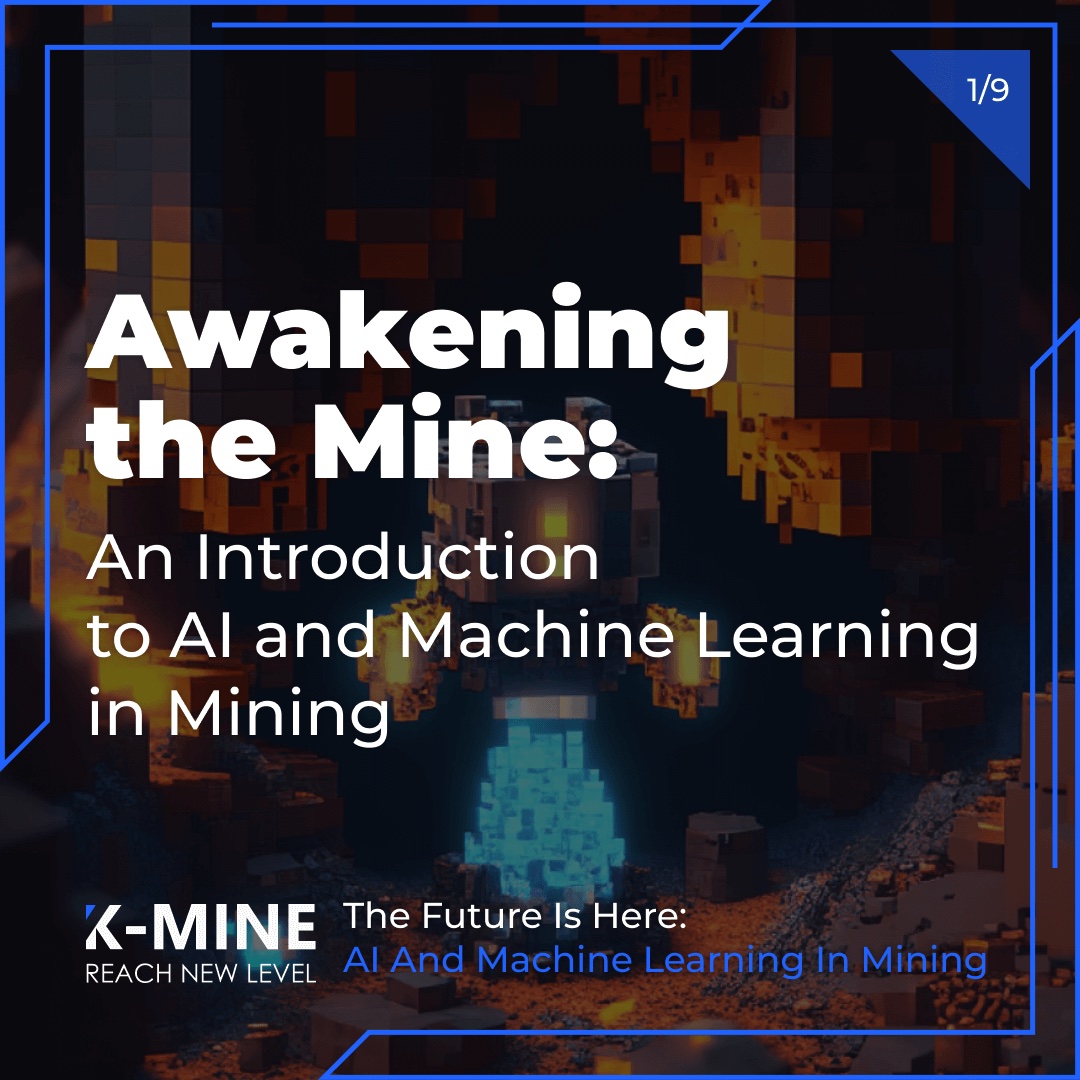
The Future is Here: AI and Machine Learning in Mining. Part 1
Content
In the dynamic world of mining, innovation is a constant companion. But even in an industry that’s no stranger to revolutionary technology, there’s something exceptionally exciting happening. A seismic shift is on the horizon, promising to change the face of mining as we know it. Enter Artificial Intelligence (AI) and Machine Learning (ML) – a dynamic duo of disruptive technologies that are poised to redefine every facet of the mining process.
These powerful tools are not just about making machines “smart”. They represent a new chapter in mining’s ongoing story of innovation – one that carries the promise of heightened safety, optimized operations, enhanced efficiency, and more precise decision-making. If the mining industry were a gold mine, AI and ML would be the modern-day equivalent of the biggest, shiniest nuggets you could ever hope to find.
So, fasten your safety helmets and prepare to delve deep into the fascinating world of AI and ML in mining.
Demystifying AI and Machine Learning
In essence, Artificial Intelligence (AI) is the ability of machines to mimic human intelligence. This doesn’t mean machines are pondering the mysteries of the universe or writing poetry. In this context, “intelligence” refers to the capability of understanding, learning from, and responding to the environment.
AI encompasses a wide range of technologies and approaches. One of the most potent among them is Machine Learning (ML). ML gives computers the ability to learn and improve from experience, without being explicitly programmed. This means that ML algorithms can adjust their output in response to new data, gradually improving their performance over time.
The concepts of AI and ML aren’t new – they were first introduced in the mid-20th century. However, it’s only in recent years that they’ve really taken off, thanks to the explosion in computational power and data availability.
In the context of mining, AI and ML offer a powerful toolkit for tackling complex problems, from predictive maintenance and process optimization, to environmental monitoring and worker safety. With their ability to learn from data, identify patterns, and make predictions, these technologies aren’t just buzzwords – they’re game-changers in the making.
AI and Machine Learning in Today’s World
Artificial Intelligence and Machine Learning are changing how we shop, work, play, and even how we interact with each other. They’re transforming industries, disrupting traditional business models, and creating new opportunities for innovation and growth. Let’s take a quick tour of how they’re being used in different sectors.
In the healthcare sector, AI and ML are helping doctors diagnose diseases, predict patient outcomes, and personalize treatment plans. They’re being used to analyze vast amounts of medical data, from electronic health records and clinical trials, to genomic sequences and biomedical images. This is leading to more accurate diagnoses, better patient care, and improved health outcomes.
In finance, they’re driving the growth of algorithmic trading, robo-advisory services, and fraud detection systems. Banks and financial institutions are using ML algorithms to analyze market data, predict trends, and make investment decisions. They’re also using them to identify unusual patterns of transactions, helping to detect and prevent fraud.
In retail, they’re powering recommendation engines, personalized marketing campaigns, and customer segmentation strategies. Online retailers are using ML to analyze customer data, understand their preferences and behaviors, and tailor their offerings accordingly. This is leading to more personalized shopping experiences, increased customer loyalty, and higher sales.
In the transportation and logistics sector, AI and ML are being used to optimize routes, predict delivery times, and manage fleets. They’re helping companies to reduce costs, improve efficiency, and enhance customer service.
And this is just the tip of the iceberg. AI and ML are also being used in agriculture, energy, manufacturing, entertainment, and countless other sectors. They’re revolutionizing the way we live, work, and do business. And now, they’re set to make a big splash in the mining industry too.
The Benefits of AI and Machine Learning in Mining
In the traditionally risk-averse and capital-intensive mining industry, AI and Machine Learning might just be the game-changers everyone has been waiting for.
The mining sector has always been a data-rich environment. From geologic models and drill logs to sensor readings from equipment, mining operations generate massive amounts of data every day. However, leveraging this data to make insightful, efficient decisions has always been a significant challenge. Here’s where AI and Machine Learning step in, unlocking unprecedented benefits.
Let’s delve into some of these advantages:
- Enhanced Operational Efficiency: AI can optimize mining operations in various ways, ranging from automating routine tasks to improving resource allocation. Predictive analytics, a branch of machine learning, can help anticipate equipment failures or maintenance needs, minimizing downtime and boosting overall productivity.
- Improved Safety: Safety is a paramount concern in the mining industry. AI can monitor worksites in real-time, identifying potential safety hazards and predicting incidents before they occur. It can analyze worker behavior, machinery operations, and environmental conditions to ensure safety standards are upheld at all times.
- Smarter Decision Making: Mining is a complex operation that involves numerous variables. Machine learning can aid in decision-making by providing data-driven insights, which can lead to more accurate forecasting and strategic planning. From deciding where to drill next, to planning the most efficient transportation routes, these smart insights can lead to significant cost savings.
- Environmental Sustainability: AI can also play a crucial role in reducing the environmental impact of mining operations. Machine learning models can optimize resource utilization, minimizing waste, and ensuring more sustainable operations. Additionally, predictive models can help anticipate and mitigate environmental risks, such as pollution or habitat disruption.
- Innovative Exploration: Identifying new mineral deposits is a costly and high-risk endeavor. AI and machine learning can transform this process by predicting potential mineral-rich areas based on geological and geospatial data. This not only reduces the time and cost associated with exploration but also increases the likelihood of successful discoveries.
These benefits are merely the tip of the iceberg. As the technology matures and adoption increases, AI and Machine Learning will continue to unlock new possibilities.
The Challenges and Considerations
Implementing AI and Machine Learning in mining, while offering numerous benefits, also comes with its own set of challenges and considerations.
Here are some key factors to be aware of:
- Data Quality: AI and Machine Learning thrive on quality data. The accuracy of the models these technologies use depends on the quality and quantity of the data they are trained with. Inadequate or inaccurate data can lead to ineffective or, worse, incorrect results.
- Data Privacy: With the increased use of AI and Machine Learning comes a rise in data collection. Ensuring the privacy and security of this data is crucial. Mining companies must be vigilant about data protection regulations and standards, and must have robust cybersecurity measures in place.
- Human Oversight: AI and Machine Learning are tools that augment human decision-making, not replace it. There is still a need for human expertise to guide these technologies and interpret their outputs. It’s important to ensure a balance between automated decision-making and human intervention.
- Change Management: Like any new technology, the introduction of AI and Machine Learning requires a change in current processes. This could mean retraining staff, revamping workflows, or investing in new equipment. The transition can be a challenging process and needs to be carefully managed.
- Ethical Considerations: There are several ethical considerations to be made when implementing AI. These include ensuring that AI does not lead to job losses, that it is used responsibly, and that it does not lead to any form of bias or unfairness.
Navigating these challenges requires a thoughtful and strategic approach. However, the potential rewards make it an exciting frontier for the mining industry to explore.
Conclusion
In this introductory article, we have embarked on the concepts of AI and Machine Learning, providing an accessible explanation of their origins and evolution. These technologies are currently being utilized across various sectors and the benefits are numerous, ranging from improved efficiency and safety to enhanced decision-making capabilities.
However, the path to AI and Machine Learning adoption is not without its challenges. Data quality and privacy, the need for human oversight, change management, and various ethical considerations all play significant roles in this transition.
As we wrap up this first article, we invite you to continue this journey with us. Together, we’ll delve deeper into specific applications, uncover more benefits, address challenges head-on, and explore the transformative effect these technologies could have on the mining industry. Stay tuned for more!



 Back
Back